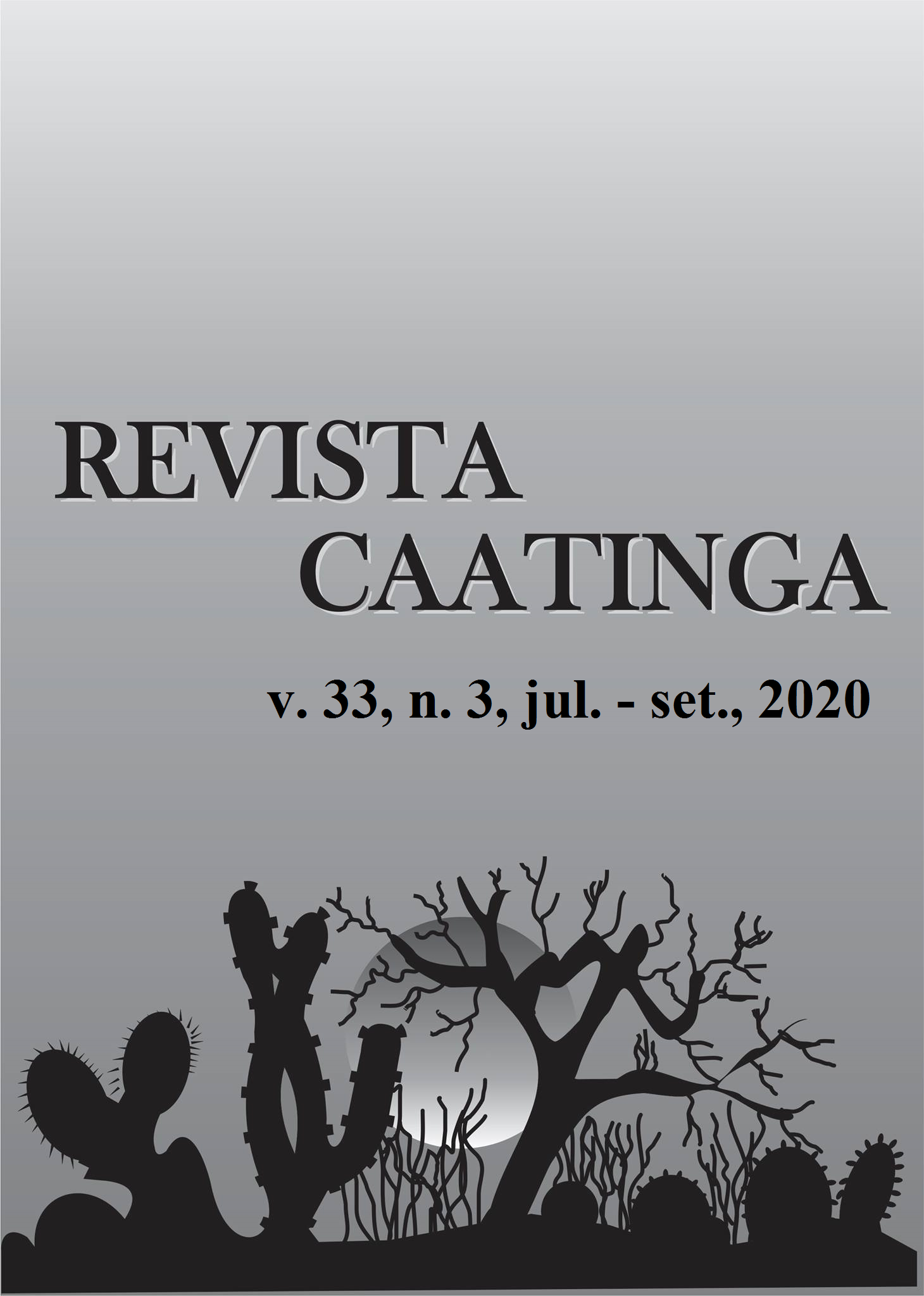WEPP MODEL FOR RILL EROSION ESTIMATION IN A BRAZILIAN SEMIARID WATERSHED
DOI:
https://doi.org/10.1590/1983-21252020v33n327rcKeywords:
Hydraulic relations. Flow rates. Erodibility. Shear stress.Abstract
Soil erosion is a major environmental problem in many parts of the world and represents a serious problem for sustainable agriculture and the environment, with direct and indirect impacts on soil quality and fertility. This study aimed to use the Water Erosion Prediction Project (WEPP) model to estimate rill erosion and determine soil physical and hydraulic properties, which are essential to investigate its performance. To this end, an experiment was carried out in the Exu Creek watershed, in Serra Talhada, semi-arid region of Pernambuco State (Brazil), under increasing flow rates: T1: 5.87 L min-1; T2: 12.10 L min-1; T3: 20.33 L min-1; and T4: 27.57 L min-1. Liquid and solid discharges were sampled for determination and characterization of hydraulic parameters in preformed rill flows. Reynolds numbers between 2,019 and 6,929 and Froude numbers below 1 found in this study attest to occurrence of erosive rills. Soil losses due to rill erosion increased as flow rates increased. Rill erodibility was 0.0011 kg N-1 s-1, and critical shear stress (τc) was 1.91 Pa, collapsing rill sidewalls and increasing local uplift, wet perimeter, and rill hydraulic radius.
Downloads
References
AMPOMAH, R. et al. A Regression-Based Prediction Model of Suspended Sediment Yield in the Cuyahoga River in Ohio Using Historical Satellite Images and Precipitation Data. Water, 12: 881, 2020.
BEZERRA, S. A. et al. Hydraulic characteristics in rill erosion in a Inceptisol the semiarid Brazil. Revista Brasileira de Ciência do Solo, 34: 1325-1332, 2010.
CANTALICE, J. R. B. et al. Relationship between bedload and suspended sediment in the sand-bed Exu River, in the semi-arid region of Brazil. Hydrological Sciences Journal, 58: 1789-1802, 2013.
DUN, S. et al. Adapting the Water Erosion Prediction Project (WEPP) model for forest applications. Journal of Hydrology, 366: 46-54, 2009.
EEKHOUT, J. P. C.; VENTE, J. The implications of bias correction methods and climate model ensembles on soil erosion projections under climate change. Earth Surface Processes and Landforms, 44: 1137-1147, 2019.
ELLIOT, W. J. et al. A compendium of soil erodibility data from WEPP cropland soil field erodibility experiments 1987 & 88. 2. ed. West Lafayette: The Ohio State University and USDA-ARS, 1989. 316 p.
GHOLAMI, V. et al. Spatial soil erosion estimation using an artificial neural network (ANN) and field plot data. Catena, 163: 210-218, 2018.
HERAS, M. M. et al. Water-related ecological impacts of rill erosion processes in Mediterranean-dry reclaimed slopes. Catena, 84: 114–124, 2011.
KNAPEN, A; POESEN, J. Soil erosion resistance effects on rill and gully initiation points and dimensions. Earth Surface Processes and Landforms, 35: 217-228, 2010.
LAFAYETTE, K. P. V.; CANTALICE, J. R. B.; COUTINHO, R. Q. Resistência à erosão em ravinas, em latossolo argilo arenoso. Revista Brasileira de Ciência do Solo, 35: 2167-2174, 2011.
MELO, R. O. et al. Susceptibilidade àcompactação e correlação entre as propriedades físicas de um Neossolo sob vegetação de Caatinga. Revista Caatinga, 21: 12-17, 2008.
MOGHADAM, B. K. et al. Effects of land-use change on soil splash erosion in the semi-arid region of Iran. Geoderma, 241: 210-220, 2015.
NICOSIA, A. et al. Testing a new rill flow resistance approach using the Water Erosion Prediction Project experimental database. Hydrological processes, 33: 616-626, 2019.
PERNAMBUCO. Secretaria de agricultura e reforma agrária. Agricultura e pecuária. Disponível em: http://www.agricultura.pe.gov.br>. Acesso em: 10 jun. 2015.
PISCOYA, V. C. et al. Riparian Buffer Strip Width Design in Semiarid Watershed Brazilian. Journal of Experimental Agriculture International, 23: 1-7, 2018.
SANTOS, H. G. et al. Sistema Brasileiro de Classificação do Solo. 3. ed. Brasília, DF: Embrapa Solos, 2013. 353 p.
SILVA, F. F. et al. Surface sealing and water erosion of soils with mulching in the semi-arid region of Brazil. Revista Brasileira de Engenharia Agrícola e Ambiental, 23: 277-284, 2019.
SIMONS, D. B.; SENTÜRK, F. Sediment transport technology. 3. ed. Fort Collins Water Resources Publications,1992. 807 p
SUN, L et al. A review on rill erosion process and its influencing factors. Chinese Geographical Science, 23: 389-402, 2013.
YAN, L. et al. Finite element method for one-dimensional rill erosion simulation on a curved slope. International Soil and Water Conservation Research, 3: 28-41, 2015.
YANG, X. et al. Near real-time monitoring of post-fire erosion after storm events: a case study in Warrumbungle National Park, Australia. International Journal of Wildland Fire, 27: 413-424, 2018.
Downloads
Published
Issue
Section
License
Os Autores que publicam na Revista Caatinga concordam com os seguintes termos:
a) Os Autores mantêm os direitos autorais e concedem à revista o direito de primeira publicação, com o trabalho simultaneamente licenciado sob a Licença Creative Commons do tipo atribuição CC-BY, para todo o conteúdo do periódico, exceto onde estiver identificado, que permite o compartilhamento do trabalho com reconhecimento da autoria e publicação inicial nesta revista, sem fins comerciais.
b) Os Autores têm autorização para distribuição não-exclusiva da versão do trabalho publicada nesta revista (ex.: publicar em repositório institucional ou como capítulo de livro), com reconhecimento de autoria e publicação inicial nesta revista.
c) Os Autores têm permissão e são estimulados a publicar e distribuir seu trabalho online (ex.: em repositórios institucionais ou na sua página pessoal) a qualquer ponto antes ou durante o processo editorial, já que isso pode gerar alterações produtivas, bem como aumentar o impacto e a citação do trabalho publicado (Veja O Efeito do Acesso Livre).







